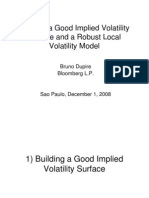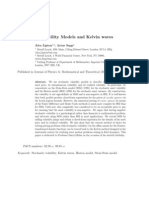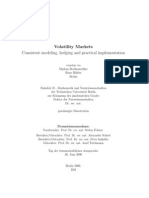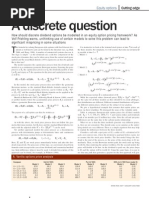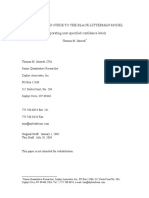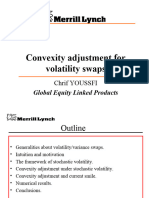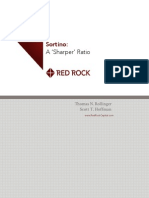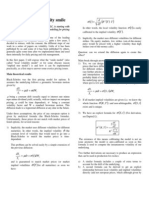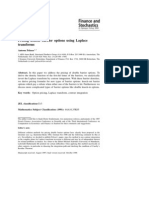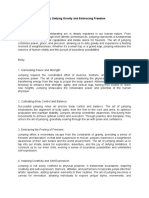From Implied To Spot Volatilities: Valdo Durrleman
From Implied To Spot Volatilities: Valdo Durrleman
Uploaded by
ginovainmonaCopyright:
Available Formats
From Implied To Spot Volatilities: Valdo Durrleman
From Implied To Spot Volatilities: Valdo Durrleman
Uploaded by
ginovainmonaOriginal Description:
Original Title
Copyright
Available Formats
Share this document
Did you find this document useful?
Is this content inappropriate?
Copyright:
Available Formats
From Implied To Spot Volatilities: Valdo Durrleman
From Implied To Spot Volatilities: Valdo Durrleman
Uploaded by
ginovainmonaCopyright:
Available Formats
Finance Stoch (2010) 14: 157177
DOI 10.1007/s00780-009-0112-1
From implied to spot volatilities
Valdo Durrleman
Received: 2 February 2007 / Accepted: 19 December 2008 / Published online: 7 November 2009
Springer-Verlag 2009
Abstract This paper is concerned with the relation between spot and implied volatil-
ities. The main result is the derivation of a new equation which gives the dynamics
of the spot volatility in terms of the shape and the dynamics of the implied volatility
surface. This equation is a consequence of no-arbitrage constraints on the implied
volatility surface right before expiry. We rst observe that the spot volatility can be
recovered from the limit, as the expiry tends to zero, of at-the-money implied volatil-
ities. Then, we derive the semimartingale decomposition of implied volatilities at any
expiry and strike from the no-arbitrage condition. Finally the spot volatility dynamics
is found by performing an asymptotic analysis of these dynamics as the expiry tends
to zero. As a consequence of this equation, we give general formulas to compute the
shape of the implied volatility surface around the at-the-money strike and for short
expiries in general spot volatility models.
Keywords Option price Implied volatility Spot volatility Martingale
representation Asymptotic analysis ItWentzell formula
Mathematics Subject Classication (2000) 60H10 91B28
JEL Classication C60 G13
I am extremely grateful to my Ph.D. advisor Ren Carmona and to Nicole El Karoui for their help
and support. I should also like to thank the referees and the editor for their constructive remarks
which have greatly enhanced the clarity of the paper.
V. Durrleman ()
Centre de Mathmatiques Appliques, cole PolytechniqueCNRS, Route de Saclay,
91128 Palaiseau, France
e-mail: valdo@cmap.polytechnique.fr
158 V. Durrleman
1 Introduction
The aim of this paper is to answer the following question: How much is known about
an underlying securitys volatility if we can observe sufciently many European call
and put option prices written on that security? More generally, we should like to better
understand the relationship between spot and implied volatilities. The usual way to
go from a spot volatility process to the corresponding implied volatilities is easy
to state but rather convoluted in practice. One has to solve the stochastic differential
equations for the stock price S together with those driving the other economic factors,
then compute expectations under the law of the terminal stock price, and nally invert
the BlackScholes formula. Implied volatilities are the market-observable quantities,
whereas is a mathematical construction which is the key concept when it comes to
the risk management of exotic options.
This important practical question has been studied for quite some time. Let us rst
mention the very well-known result of [5]. If C
t
(T, K) denotes the price at time t
of a call option with strike K and maturity T , then knowing C
t
(T, K) at time t for
all K and for a given T is equivalent to knowing the risk-neutral distribution of the
terminal value of the stock price S
T
.
An important further step was achieved in [11, 12], and [23]. For instance, it is
shown in [12] that under the assumption that the spot process is continuous and
Markov under the pricing measure, the distribution of the process describing the fu-
ture evolution is completely specied by implied volatilities. More precisely, let us
suppose that the spot volatility is a deterministic function of the current spot price and
possibly time, say, (t, S). The above works show that we can recover this function if
we observe the entire implied volatility surface (as a function of T and K) at a given
date.
We tackle this problem from a different angle in the sense that we study dynamics
instead of focusing on data at a given date. Loosely speaking, the previous works used
Markov methods where (t, ) are essentially xed, whereas (T, K) vary. We keep
(T, K) xed and let (t, ) vary. As explained by [17] and [8] among many others,
such a dynamical approach is very useful from a practitioners point of view. Implied
volatility dynamics are crucial when it comes to risk management of portfolios of
options. Having a model for the implied volatility dynamics allows one to calculate
the different vega risks in a consistent manner. Dynamics are also crucial for hedging
exotic options. This is particularly clear in the case of a barrier option: Its price is
precisely a function of the implied volatility smile when the spot touches the barrier,
as made apparent by the classical static hedging argument of [3].
To solve the problem, we take a point of view that is very close to that of [18],
where a continuum of assets is modeled. We consider here a market where the pri-
mary securities are the spot and liquid options on it. We restrict ourselves to a contin-
uous spot process. Apart from that, we try to make as few assumptions as possible on
the spot dynamics in order to have the most general understanding. We shall see that
there is a lot of information about the spot process that is contained in option prices.
In fact, we shall see that under some regularity conditions, one can recover the spot
volatility dynamics by observing implied volatilities dynamics.
From implied to spot volatilities 159
First, the observation is made that at any time t , the implied volatility of a very
short maturity at-the-money option is equal to the spot volatility (corollary to Theo-
rem 3.1). Therefore the dynamics of the spot volatility can be obtained from the limit
of the implied volatility surface dynamics as the time to maturity tends to zero. The
martingale representation theorem yields a predictable representation for the price of
a vanilla option (and hence its implied volatility) in terms of the underlying Wiener
process. It is then shown that subject to suitable conditions, the implied volatility sur-
face at time t is a family of semimartingales parameterized in a continuous fashion
by time to maturity and strike. The DoobMeyer decomposition of this semimartin-
gale is then obtained from the ItWentzell formula (Proposition 3.4). The limit of
this semimartingale as the time to maturity tends to zero in this decomposition is
taken by using dominated convergence and continuity of quadratic variation, which,
as originally observed, gives a semimartingale decomposition of the spot volatility
process.
A few papers ([4, 21, 24], and more recently, [25]) have already studied a nancial
market where the primary securities are the spot and liquid options on it. These papers
look at the problem of modeling implied volatilities in an arbitrage-free way. We do
not tackle this very interesting and challenging problem. Instead, we take the implied
volatility dynamics as given and perform an asymptotic analysis to nd new and
interesting relations between the spot and implied volatilities.
For an excellent survey on the subject of implied volatilities, one should con-
sult [22]. The book [16] provides an excellent account on the topic from the practical
perspective.
Modeling implied volatilities is equivalent to modeling option prices, as seen
in (2.3), and it is merely a parameterization of options volatilities. The difculties
in modeling implied volatilities have led researchers to look for other and possibly
more tractable parameterizations.
First, following a program started in [6, 10] model option prices by modeling
Dupires local volatility as a random eld. They are able to nd explicit drift con-
ditions and some examples of such dynamics. The Dupire local volatility surface
species the spot volatility in the short maturity limit just like implied volatilities do
(corollary to Theorem 3.1). However, it does not have complicated static arbitrage
restrictions in terms of buttery, call, and calendar spreads like implied volatilities
(see, for instance, [16]).
Another way of parameterizing option prices consists in modeling their intrinsic
values, i.e., the difference between the option price and the payoff if the option was
exercised today. This is the approach taken by [19] in a very general semimartin-
gale framework. Exactly as with implied volatilities (corollary to Theorem 3.1), this
approach yields a spot specication when options are close to maturity.
Finally, let us mention the recent work [26], where the authors introduce newquan-
tities, the local implied volatilities and price level, to parameterize option prices.
These have nicer dynamics and naturally satisfy the static arbitrage conditions. They
derive an existence result for the innite system of equations driving these quantities.
The paper is organized as follows. Section 2 introduces the framework and nota-
tion for the derivation of the main results. In Sect. 3 we establish the main results of
the paper, namely Theorems 3.1 and 3.2. In Sect. 4, we study the particular case of
160 V. Durrleman
stochastic volatility models. Finally, Sect. 5 hints at potential applications of these
results.
2 The implied volatility surface dynamics and its boundary behavior
2.1 Framework and notation
Let (, H, P) be a probability space with an n-dimensional Wiener process (W
t
)
t 0
on it. We shall use boldface letters for vectors. If x and y are two vectors, then x y
denotes their usual scalar product and |x| the Euclidean norm of x. The ltration
generated by the Wiener process has been augmented as usual and is denoted by
(F
t
)
t 0
. We assume that the probability measure P is risk neutral, that is, discounted
price processes are local martingales if there is no arbitrage in the market. This as-
sumption is based on the famous fundamental theorem of asset pricing (see, e.g., [9]).
We rst dene the risk-neutral stock process S. For simplicity, we assume that
interest rates are zero, but it would make no difference here if they were deterministic
functions of time. We are given a spot volatility process taking values in R
n
, which
is jointly measurable, adapted to the ltration (F
t
)
t 0
, and satises the integrability
condition
t 0
_
t
0
|
s
|
2
ds < a.s. (2.1)
Since satises (2.1), we can dene S to be the stochastic exponential
S
t
=S
0
exp
__
t
0
s
dW
s
1
2
_
t
0
|
s
|
2
ds
_
.
In other words, S is a typical positive local martingale in a Brownian ltration. We
shall assume that it is a martingale. Let us stress that is adapted to the entire l-
tration (F
t
)
t 0
generated by (W
t
)
t 0
, which usually is larger than that generated by
(S
t
)
t 0
. In nancial terms, we do not assume market completeness. We make the
following basic nondegeneracy assumption:
Assumption 1 S is a martingale (relative to (F
t
)
t 0
), and |
t
()| > 0, Leb P-a.e.
Our main and fundamental assumption is that options are liquid instruments, just
as the stock itself. Each option is therefore an attainable claim, and in the absence of
arbitrage opportunities, we can assume that option prices agree with the risk-neutral
expectation of their terminal payoffs.
More precisely, let t 0, T > t , and K > 0 be xed; C
t
(T, K) denotes the price
at time t of the call option struck at K with maturity T .
Assumption 2 For every T > t and K,
C
t
(T, K) =E
_
(S
T
K)
+
F
t
_
a.s. (2.2)
From implied to spot volatilities 161
The fact that call prices are martingales will play a key role in deriving the implied
volatility dynamics via the martingale representation theorem in Sect. 2.3.
We wish to study C
t
(T, K) as a function of (T, K). We are dealing with an un-
countable family of stochastic processes indexed by (T, K). We assume that all these
processes have been constructed simultaneously on our probability space.
Assumption 3 For every T > t and K,
(S
t
K)
+
< C
t
(T, K) < S
t
a.s.
Given an option price C
t
(T, K), Assumption 3 ensures that C
t
(T, K) is in the
range of the BlackScholes formula. We can therefore dene the BlackScholes im-
plied volatility
t
(T, K) as the unique volatility parameter for which the Black
Scholes formula recovers the option price. In other words,
t
(T, K) is the unique
solution to the equation
KBS
_
S
t
/K,
t
(T, K)
T t
_
=C
t
(T, K), (2.3)
where BS is the normalized BlackScholes function
BS(u, v) =u
_
lnu
v
+
v
2
_
_
lnu
v
v
2
_
.
We use the notation (x) and (x) for the density and the cumulative distribution
functions of the standard Gaussian distribution.
Assumption 3 ensures that for every T > t and K,
t
(T, K) > 0 a.s.
2.2 Boundary behavior
In this subsection, we study the behavior of implied volatilities just before maturity.
This behavior is intimately related to that of the corresponding option prices.
In the absence of arbitrage, option prices are continuous in maturity. Indeed, we
can rewrite (2.2) as
C
t
(T, K) =E
P
t
_
(S
T
K)
+
_
,
where we denote by P
t
a xed version of the regular conditional distribution of the
process S under P with respect to F
t
. Since S is a martingale, callput parity yields
C
t
(T, K) =S
t
K E
P
t
_
(K S
T
)
+
_
,
and the dominated convergence theorem(puts are bounded by their strikes) gives that,
for each t 0, we have
lim
T t
C
t
(T, K) =(S
t
K)
+
a.s. (2.4)
This property translates into the following for the implied volatilities:
162 V. Durrleman
Proposition 2.1 For t and K > 0 xed,
lim
T t
t
(T, K)
T t =0 a.s. (2.5)
Proof Suppose that limsup
T t
t
(T, K)
T t > 0. This would then imply that
limsup
T t
KBS(S
t
/K,
t
(T, K)
T t ) > (S
t
K)
+
. In view of (2.3), that would
contradict (2.4).
Proposition 2.2 For every K > 0,
lim
0
t
(t +, K)
=0
in the sense of uniform convergence on compact intervals in t and in probability
(u.c.p. for short).
Proof Let
n
0. From Proposition 2.1 we know that for every t and K,
t
(t +
n
, K)
n
goes to 0 for a.e. as n goes to innity. To show that the pointwise
limit is in fact uniform in t on compact intervals for a.e. , we note that call option
prices are increasing with maturity (recall that interest rates are zero) and therefore
that
t
(t +, K)
is increasing. Then, using Dinis theorem since the limit
is obviously continuous, we get the uniform convergence in t for any decreasing se-
quence (
n
). Now, let us take an arbitrary sequence
n
0; we want to show that
t
(t +
n
, K)
n
converges to 0 uniformly in t on compacts and in probability. Take
a subsequence (
n
k
); it has a further subsequence that is decreasing to 0, and the pre-
ceding reasoning applies to that subsequence. The convergence therefore holds in the
sense of uniform convergence on compacts in t and in probability.
The proposition above is the rst key ingredient of the paper. The second ingredi-
ent is the implied volatility dynamics (more precisely, the implied variance dynam-
ics). This is the content of the next section.
2.3 Implied volatility dynamics
We are going to derive the dynamics for from that of C. In view of (2.2), for each
(T, K), C(T, K) is a martingale adapted to a Brownian ltration. By the martingale
representation theorem, we write it as a stochastic integral. More specically, there
exists an adapted process H(T, K) such that for t T ,
C
t
(T, K) =C
0
(T, K) +
_
t
0
H
s
(T, K) dW
s
.
We assume that such a representation holds simultaneously for all T > t and K a.s.,
and H
t
(T, K) is a family of stochastic processes indexed by T > t and K.
By Assumption 3,
t
(T, K) > 0 for (T, K) (t, +) (0, +) a.s. We can
therefore dene the random variables
t
(T, K) for (T, K) (t, +) (0, +) by
t
(T, K) =
H
t
(T, K) (d
1
)S
t
t
S
t
t
(T, K)
T t (d
1
)
, (2.6)
From implied to spot volatilities 163
where, as usual, d
1
=
ln(S
t
/K)
t
(T,K)
T t
+
1
2
t
(T, K)
T t . Then, the martingale rep-
resentation takes the form
C
t
(T, K) =C
0
(T, K) +
_
t
0
S
s
_
(d
1
)
s
+
s
T s(d
1
)
s
_
(T, K) dW
s
.
Writing H
t
(T, K) in this way will prove easier to handle when it comes to the study
of implied volatilities.
The above martingale representation has the following nancial interpretation.
To manage the risk of a short option, one can buy the BlackScholes quantity of
= (d
1
) stocks, whose dynamics are given by the rst term above. The second
term is a correction term proportional to the vega that takes into account the fact that
the spot volatility is not constant. In the BlackScholes world, that last term would be
zero, and the risk management of the short option could be done with a self-nancing
portfolio consisting solely of S and a risk-free bank account.
Its formula shows that for xed (T, K), (
t
(T, K)) is a semimartingale on
t T . The proposition below gives its decomposition. From it, we note that
t
(T, K)
has the interpretation of the implied volatilitys volatility vector.
Proposition 2.3 For xed (T, K) and t < T ,
t
(T, K)
T t =
0
(T, K)
T
_
t
0
_
|
s
ln(S
s
/K)
s
|
2
2
s
T s
+
1
2
T s
s
s
1
8
3
s
(T s)
3/2
|
s
|
2
_
(T, K) ds
+
_
t
0
s
(T, K)
T s
s
(T, K) dW
s
.
Proof Since C
t
(T, K) = KBS(S
t
/K,
t
(T, K)
T t ), it sufces to show that
we recover the correct martingale representation for C
t
(T, K) if we assume that
t
(T, K)
T t has the semimartingale decomposition stated in the proposition.
This is a simple application of Its formula.
3 The spot volatility dynamics in terms of implied volatilities
In this section, we prove our main results, namely, Theorems 3.1 and 3.2.
3.1 Assumptions
In order to perform our asymptotic analysis of the implied volatility surface, we need
to make a few assumptions on the implied volatility surface
t
and on its volatility
vector
t
. Throughout
T
and
K
will denote partial derivatives with respect to T
and K.
164 V. Durrleman
Assumption 4 For every t and a.s.,
K > 0, T
t
(T, K) is C
1
on (t, +),
T > t, K
T
t
(T, K) is C
3
on (0, +),
T > t, K
t
(T, K) is C
4
on (0, +),
T > t, K
t
(T, K) is C
4
on (0, +).
This last assumption is a mild one. It guarantees smoothness of the implied volatil-
ity surface in the open set (t, +) (0, +). As we shall explain in Sect. 4, it holds
in any stochastic volatility model with smooth coefcients. However it says nothing
about the behavior of the surface as T t . For that, we need the following two
assumptions.
Assumption 5 For every K and t , the families of random variables (indexed by )
t
(t +, K),
T
t
(t +, K),
K
t
(t +, K), and
2
K
t
(t +, K)
have a limit in probability as decreases to 0. The limits are denoted by
t
(t, K),
T
t
(t, K),
K
t
(t, K), and
2
K
t
(t, K).
Similarly,
t
(t +, K),
K
t
(t +, K), and
2
K
t
(t +, K) have a limit in probability
as decreases to 0, with limits denoted by
t
(t, K),
K
t
(t, K), and
2
K
t
(t, K).
This last assumption gives us existence of limits for the implied volatility surface
and its volatility vector.
Assumption 6 For every compact set K(0, +) and t , there exists a
> 0 such
that for every p 0,
_
t
0
sup
KK
sup
0<
_
4
i=0
i
K
p
+
3
i=0
i
K
p
_
(s +, K) ds <+ a.s.
and
_
t
0
sup
KK
sup
0<
_
4
i=0
i
K
s
(s +, K)
p
_
ds <+ a.s.
This assumption gives us convenient integrability conditions, so that we shall be
able to easily interchange limits and Lebesgue or It integrals. We actually only need
these integrability conditions for p 10. We shall show in Sect. 4 that all the above
assumptions hold for a wide class of stochastic volatility models.
From implied to spot volatilities 165
3.2 The relation between implied volatilities and their volatility vectors
at short maturities
The goal of this subsection is to prove the following result relating implied volatilities
and their volatility vectors at short maturities.
Theorem 3.1 For every K and almost every t ,
t
(t, K) =
t
ln
_
S
t
K
_
t
(t, K)
a.s. (3.1)
Proof The rst step towards this theoremis to use Its formula to get the semimartin-
gale decomposition of the processes
t
(t +, K). This is possible since
t
(T, K) is
C
1
in T (Assumption 4). We obtain that for each > 0,
t
(t +, K)
2
=
0
(, K)
2
+
_
t
0
_
2
s
s
+
2
s
2
s
s
s
s
ln(S
s
/K)
s
2
+
2
4
4
s
|
s
|
2
+
2
s
|
s
|
2
_
(s +, K) ds
+
_
t
0
2
2
s
s
(s +, K) dW
s
.
The main idea of the proof is to take the limit 0 in the previous equation. We
are going to see that most terms will have limit 0 in probability. Let us x K. From
Proposition 2.2 we have
P- lim
0
t
(t +, K)
2
=P- lim
0
0
(, K)
2
=0
uniformly on compact time intervals. Here and throughout the rest of the paper, the
notation P-lim will denote convergence in probability. On the other hand, by As-
sumption 6 and the CauchySchwarz inequality,
P- lim
0
_
t
0
_
2
2
s
s
(s +, K)
_
2
ds =0,
which yields, using Theorem 2.2.15 of [20], that
P- lim
0
_
t
0
2
2
s
s
(s +, K) dW
s
=0
uniformly on compacts in time.
Similarly, repeated use of Assumption 6 and the CauchySchwarz inequality
yields that
P- lim
0
_
t
0
_
2
s
s
+
2
4
4
s
|
s
|
2
+
2
s
|
s
|
2
_
(s +, K) ds =0
166 V. Durrleman
uniformly on compacts in time. We nally get
P- lim
0
_
t
0
_
s
(s +, K)
s
ln(S
s
/K)
s
(s +, K)
2
_
ds =0.
Using Assumption 5, Assumption 6, and the dominated convergence theorem, we get
_
t
0
_
s
(s, K)
s
ln(S
s
/K)
s
(s, K)
2
_
ds =0.
The result follows since t is arbitrary.
The statement of Theorem 3.1 is similar to the no-bubble restriction of [24]. The
main difference is that in [24], only one option with maturity T is considered, and
the limit is taken as t approaches T . Our point of view is different: todays date t is
xed, and we look at a continuum of option prices and at the limit as T approaches t .
The case where we let K =S
t
in Theorem 3.1 is particularly important. It says that
t
(t, S
t
) =|
t
|. (3.2)
In other words, the current value of the spot volatility can be exactly recovered from
the implied volatility smile. It is given by the short maturity limit of at-the-money im-
plied volatilities. This relation is called feedback condition in [4] and was known
to hold for some time (see, for instance, [7]).
Completely independently of the present paper, [14] shows that (3.2) holds in great
generality even when jumps in the spot and/or the volatility are present.
Let us now draw parallels between our result and the important results obtained
in [2]. In that paper, the authors show that in a time-homogeneous stochastic volatility
model, the implied volatility in the short maturity limit can be expressed using the
geodesic distance associated with the generator of the bivariate diffusion (x
t
, y
t
),
where x
t
is the log-moneyness, and y
t
is the spot volatility (|
t
| in our notation).
Keeping their notation, we denote by d(x, y) the geodesic distance from (x, y) to
(0, y), that is,
d(x, y) = inf
(0)=(x,y)
(1)=(0,y)
_
1
0
_
2
i,j=1
g
ij
i
(t )
j
(t ) dt,
where g
ij
is the ijth element of the inverse of the diffusion matrix of the bivariate
diffusion (x
t
, y
t
), and are continuously differentiable paths starting from (x, y) and
ending at (0, y). denotes their derivatives with respect to their parameter. The result
of [2] is that
t
(t, K) =
| ln(S
t
/K)|
d(ln(S
t
/K), |
t
|)
. (3.3)
It is now very tempting to compare (3.1) and (3.3) to relate the geodesic distance
to the implied volatility surfaces volatility vector
t
(T, K). The relation actually is
d
_
x, |
t
|
_
=
|x|
|
t
x
t
(t, S
t
e
x
)|
.
From implied to spot volatilities 167
As (3.3) indicates,
t
(t, K) has the interpretation of the ratio between the usual
Euclidean and geodesic distances between (ln(S
t
/K),
t
) and (0,
t
). Our theorem
gives another interpretation of
t
(t, K), namely
t
(t, K) =
t
ln
_
S
t
K
_
t
(t, K)
.
This is the Euclidean norm of the difference of the spot volatility vector and the
implied volatilitys volatility vector multiplied by log-moneyness.
3.3 The spot volatilitys semimartingale decomposition in terms
of implied volatilities
In this subsection we prove the following theorem, which is the main result of the pa-
per. It gives a semimartingale decomposition of the spot volatility in terms of implied
volatilities.
Theorem 3.2 There exists a scalar Wiener process W
on (, H, P) adapted to
(F
t
)
t 0
such that for every t ,
|
t
|
2
= |
0
|
2
+
_
t
0
_
4|
s
|
s
T
(s, S
s
) +6|
s
|
2
_
S
s
s
K
(s, S
s
)
_
2
+2|
s
|
3
S
2
s
s
K
2
(s, S
s
)
_
ds
+
_
t
0
4|
s
|
s
K
(s, S
s
) dS
s
+
_
t
0
2|
s
|
2
s
dW
s
,
where
_
t
_
2
=
2
|
t
|
d
dt
_
S
t
,
t
K
(t, S
t
)
_
+2
_
S
t
t
K
(t, S
t
)
_
2
|
t
|S
t
t
K
(t, S
t
)
3|
t
|S
2
t
t
K
2
(t, S
t
).
Moreover, the two local martingales appearing in the decomposition are orthogonal
in the sense that
__
t
0
4|
s
|
s
K
(s, S
s
) dS
s
,
_
t
0
2|
s
|
2
s
dW
s
_
=0.
The proof is done in several steps.
Proposition 3.3 For each > 0, the family of processes
t
(t +, K) is a C
3
semi-
martingale in the sense of [20].
168 V. Durrleman
Proof To check that the family of processes
t
(t + , K) is a C
3
semimartingale
(see the denition on pp. 79 and 84 in [20]), we introduce the local characteristics
(see the denition on p. 84 in [20])
b(s, K) =
_
2
s
s
+
2
s
2
s
s
s
s
ln(S
s
/K)
s
2
+
2
4
4
s
|
s
|
2
+
2
s
|
s
|
2
_
(s +, K)
and
a(s, K, L) =4
2
2
s
(s +, K)
2
s
(s +, L)
s
(s +, K)
s
(s +, L).
In order for the bounded variation process (
_
t
0
b(s, K) ds) to be a C
3
process
of bounded variation, it is enough to check that, for every t and compact set
K(0, +),
_
t
0
sup
KK
3
i=0
i
K
b(s, K)
ds <+.
Our Assumption 6 guarantees that this integral is indeed nite.
In order for the local martingale part to be a C
3
local martingale, it is enough to
check that, for every t and compact set K(0, +),
_
t
0
sup
K,LK
4
i=0
i
K
i
L
a(t, K, L)
ds <+.
Indeed, the joint quadratic variation
_
t
0
a(s, K, L) ds will have a modication as a
continuous C
4
process, and the local martingale part will have a modication as a
continuous C
3
local martingale thanks to Theorem 3.1.2 in [20]. Now, the integrabil-
ity condition above follows right away from our Assumption 6.
Proposition 3.4 For each > 0,
t
(t +, S
t
)
2
is a semimartingale whose decom-
position is given by
t
(t +, S
t
)
2
=
0
(, S
0
)
2
+
_
t
0
_
2
s
s
+
1
2
s
|
s
|
2
_
2
s
s
s
+
4
4
s
|
s
|
2
+
2
s
|
s
|
2
+S
2
s
|
s
|
2
_
2
K
s
+(
K
s
)
2
_
+4S
s
s
s
+2S
s
2
s
s
K
s
_
(s +, S
s
) ds
+
_
t
0
_
2
2
s
s
+2S
s
s
_
(s +, S
s
) dW
s
.
From implied to spot volatilities 169
Proof The proposition is simply an application of the ItWentzell formula (Theo-
rem 3.3.1 in [20]) to the family of processes
t
(t +, K)
2
. The assumptions of that
theorem are satised:
t
(t + , K)
2
is both a C
2
process and a C
1
semimartingale
thanks to Proposition 3.3. The local characteristics have the required integrability as
can be seen from the proof of Proposition 3.3.
Proposition 3.5 |
t
|
2
is a semimartingale whose decomposition is given by
|
t
|
2
= |
0
|
2
+
_
t
0
_
4
s
s
2
s
s
s
+
2
s
|
s
|
2
+S
2
s
|
s
|
2
2
K
s
+
_
|
s
|S
s
s
_
2
+4S
s
s
s
+2S
s
2
s
s
K
s
_
(s, S
s
) ds
+
_
t
0
_
2
2
s
s
+2S
s
s
_
(s, S
s
) dW
s
.
Proof We now simply take the limit as goes to 0 in the semimartingale decom-
position of Proposition 3.4. Fix t and . First of all, Assumption 5 and (3.2) imply
that
lim
0
t
(t +, S
t
)
2
=|
t
|
2
,
and similarly with t =0.
In the bounded-variation part,
_
t
0
2
s
(s +, S
s
) |
s
|
2
ds =
_
t
0
2[
s
s
](s +
s
, S
s
) ds
for some 0 <
s
< by the mean value theorem. Each term of the bounded variation
part converges by dominated convergence thanks to Assumptions 5 and 6. Note that
S is a continuous process and that, thanks to Assumptions 5 and 6,
_
t
0
|
s
|
p
ds <+
for every p 0 and t 0.
For the local martingale part, we have, thanks to Assumptions 5 and 6, that
P- lim
0
_
t
0
_
2
2
s
s
+2S
s
s
_
(s +, S
s
)
_
2
2
s
s
+2S
s
s
_
(s, S
s
)
2
ds =0.
Thanks to Theorem 2.2.15 in [20], this implies that
P- lim
0
_
t
0
_
2
2
s
s
+2S
s
s
_
(s +, S
s
) dW
s
=
_
t
0
_
2
2
s
s
+2S
s
s
_
(s, S
s
) dW
s
.
We nally obtain the semimartingale decomposition stated in the proposition.
170 V. Durrleman
Proposition 3.5 gives the semimartingale decomposition of |
t
|. The remaining
task is now to compute
t
t
(t, S
t
) and
t
K
t
(t, S
t
) in terms of implied volatili-
ties. This will be done in several steps using Theorem 3.1. We are using it to give us
a Taylor expansion of
t
(t, K) in K around S
t
. To that end, we dene the family of
processes
t
(t +, K) by
t
(t +, K) =
t
(t +, K)
t
t
(t +, K)
|
t
|
2
t
. (3.4)
The second term on the right-hand side is simply the orthogonal projection of
t
(t +, K) onto
t
.
Proposition 3.6 For almost every t ,
t
t
(t, S
t
) = |
t
|S
t
t
(t, S
t
),
S
t
t
K
t
(t, S
t
) =
1
2
_
|
t
|
_
S
t
t
(t, S
t
) +S
2
t
2
K
t
(t, S
t
)
_
t
(t, S
t
)
2
_
.
Proof The statement of Theorem 3.1 can be rewritten as
t
(t, K) =
_
1
t
t
(t, K)
|
t
|
2
ln
_
S
t
K
__
t
ln
_
S
t
K
_
t
(t, K)
,
which can be inverted as
t
t
(t, K) =
|
t
|
ln(S
t
/K)
_
|
t
|
_
t
(t, K)
2
ln
2
(S
t
/K)
t
(t, K)
2
_
.
Thanks to Assumption 6, the functions K
t
(t, K) and K
t
(t, K) are C
2
and
C
1
, respectively, and their derivatives in K are equal to the limits of the derivatives as
0. It simply remains to compute the value and the rst derivative of
t
t
(t, K)
at S
t
by expanding the right-hand side of the above equation.
Proposition 3.6 gives us the crucial quantity
t
K
t
(t, S
t
) in terms of |
t
(t, S
t
)|.
However, we still need to relate |
t
(t, S
t
)| to the implied volatilities. |
t
(t, S
t
)| will
depend on the joint quadratic variation of S and the at-the-money skew
K
t
(t, S
t
).
We rst compute this joint quadratic variation in the next proposition.
Proposition 3.7 For every > 0,
K
2
t
(t + , S
t
) is a semimartingale whose de-
composition is given by
2
t
(t +, S
t
) =
K
2
0
(, S
0
) +
_
t
0
K
_
2
s
s
2
s
s
s
+
1
2
s
s
ln(S
s
/K)
s
2
_
+
4
4
s
|
s
|
2
+
2
s
|
s
|
2
+
|
s
|
2
2
S
2
s
2
K
2
s
+2S
s
K
_
2
s
s
_
s
_
(s +, S
s
) ds
+
_
t
0
_
S
s
2
K
2
s
s
+2
K
_
2
s
s
__
(s +, S
s
) dW
s
.
From implied to spot volatilities 171
Proof Proposition 3.3 gives us that
t
(t + , K) is a C
3
semimartingale for each
> 0. It follows from the denition of C
3
semimartingales that
K
t
(t +, K)
2
is
a C
2
semimartingale whose semimartingale decomposition is given by interchanging
derivatives with respect to K and integrals. More precisely,
2
t
(t +, K) =
K
2
0
(, K) +
_
t
0
K
_
2
s
s
2
s
s
s
+
1
2
s
s
ln(S
s
/K)
s
2
_
+
4
4
s
|
s
|
2
+
2
s
|
s
|
2
_
(s +, K) ds
+
_
t
0
2
K
_
2
s
s
_
(s +, K) dW
s
.
Exactly as in Proposition 3.4, we apply the ItWentzell formula to get the semi-
martingale decomposition of
K
2
t
(t +, S
t
). The assumptions needed to apply The-
orem 3.3.1 of [20] are satised thanks to Proposition 3.3.
We now take the limit as 0 in the previous proposition. It will lead to a new
relation involving
t
t
(t, S
t
) and
t
K
t
(t, S
t
), from which we nd |
t
(t, S
t
)|.
Proposition 3.8 For almost every t ,
t
(t, S
t
)
2
=
2
|
t
|
d
dt
_
S
t
,
K
t
(t, S
t
)
_
+2
_
S
t
t
(t, S
t
)
_
2
|
t
|S
t
t
(t, S
t
) 3|
t
|S
2
t
2
K
t
(t, S
t
).
Proof Exactly as in Proposition 3.5, we prove that the bounded variation part and the
martingale part of the semimartingale decomposition of
K
2
t
(t +, S
t
) have limits
as 0. The limits can be computed as before. The joint quadratic variation of the
limit and S is given by
_
t
(t, S
t
), S
t
_
=
_
t
0
_
S
s
s
s
+|
s
|S
s
s
K
s
+|
s
|
2
S
2
s
2
K
s
_
(s, S
s
) ds.
It remains to express
t
t
(t, S
t
) and
t
K
t
(t, S
t
) using Proposition 3.6 and to
differentiate with respect to t .
We can now complete the proof of Theorem 3.2. We simply replace
t
t
(t, S
t
),
t
K
t
(t, S
t
) with the expressions we have computed in Propositions 3.6 and 3.8
and use the fact that (see (3.4))
t
(t, S
t
)
2
=
t
(t, S
t
)
2
+
_
t
t
(t, S
t
)
_
2
.
172 V. Durrleman
This yields
|
t
|
2
= |
0
|
2
+
_
t
0
_
4|
s
|
T
s
(s, S
s
) +6|
s
|
2
_
S
s
s
(s, S
s
)
_
2
+2|
s
|
3
S
2
s
2
K
s
(s, S
s
)
_
ds +
_
t
0
_
2
2
s
s
+4S
s
s
_
(s, S
s
) dW
s
.
Now, thanks to Lvys theorem, we dene the new Wiener process W
as
W
t
=
_
t
0
_
t
(t, S
t
)
|
t
(t, S
t
)|
1
{|
t
(t,S
t
)|=0}
+
s
|
s
|
1
{|
t
(t,S
t
)|=0}
_
dW
s
.
This completes the proof of the theorem.
4 The special case of stochastic volatility models
The goal of this section is to prove Proposition 4.2, which will give us sufcient
conditions for Assumptions 16 to hold. This section makes use of [1] and [2]. We
are going rst to recall the precise statement of their result.
As in [2], we focus here on stochastic volatility models. More precisely, we con-
sider a stock price process which follows a stochastic differential equation of the type
dS
t
S
t
= (t, S
t
, y
t
) dW
t
,
dy
t
= (t, y
t
) dt +(t, y
t
) dZ
t
,
where W = Z
0
, Z = (Z
1
, . . . , Z
n1
) are standard Wiener processes. We dene the
correlation matrix = (
ij
)
1i,jn1
by Z
i
t
, Z
j
t
=
ij
t . is the vector of drift
coefcients, and is the diffusion matrix. y
t
takes values in R
n1
, and we assume
that S
t
(0, +).
If (F
t
)
t 0
is the ltration generated by (Z
0
, . . . , Z
n1
), then the value of a Euro-
pean call option with strike K and maturity T is given by the conditional expectation
C(t, S
t
, y
t
) =E
_
(S
T
K)
+
F
t
_
.
We introduce the new variables =T t , x
1
=ln(S/K), and x
i
=y
i1
for i 2.
In such models, the implied volatility is a deterministic function of time and the
factors, i.e.,
t
(T, K) =
(t, S
t
, y
t
, T, K).
We verify that Assumptions 16 hold when the implied volatility has this form.
We introduce the following notation. The correlation matrix is now = (
ij
)
with
ij
=
i1,j1
, and i, j now run from 1 to n. The diffusion matrix is given
by M = (m
ij
) with m
11
= , m
1k
= m
k1
= 0 if k = 1, and m
ij
=
i1,j1
if
2 i, j n. The drifts are dened as q
1
=
1
2
2
(t, S, y), q
i
=
i1
for i =2, . . . , n.
We also dene
1
=0 and
i
=q
i
+
1i
i1
.
From implied to spot volatilities 173
Note that q, are vectors and functions of (, x) whereas M is a matrix and also
a function of (, x). Let us make the following assumption:
Assumption 7 As functions of (, x) (0, T ) R
n
, each component of the vector
q and the matrix MM
are C
. Also, there exists a constant C such that for all
x, v R
n
and all (0, T ),
C
1
_
1 +|x|
_
2
|v|
2
_
MM
(, x)v
_
v C
_
1 +|x|
_
2
|v|
2
.
Here and throughout the rest of the paper, we denote by
the differentiation with
respect to and by the gradient with respect to the variable x.
2
will denote the
Hessian matrix, Tr the trace, and
transpose. Finally, for any two vectors a and b,
a b is the matrix whose ijth entry is a
i
b
j
.
With this notation, we are in a position to state the result taken from Proposi-
tion 1.2 in [2].
Proposition 4.1 Under Assumption 7, the implied volatility function is the unique
solution
(, x) W
1,2,
loc
((0, T ) R
n
) of the well-posed nonlinear degenerate par-
abolic initial value problem
2
_
=H
_
, x,
,
,
2
_
(4.1)
with the initial condition
(0, x) =
0
(x), where
0
is the unique solution to
H
_
0, x,
,
,
2
_
=0.
The function H is given by
H = Tr
_
MM
2
_
_
x
1
_
x
1
2
4
__
+
+
Tr
_
MM
_
.
Here W
1,2,
loc
((0, T ) R
n
) denotes the Sobolev space of functions that are al-
most everywhere once differentiable in on (0, T ) and twice in x on R
n
, and whose
derivatives are bounded on every compact in (0, T ) R
n
.
This result shows in particular that the function
is continuous on [0, T ) R
n
.
Since
t
(T, K) =
_
T t, ln(S
t
/K), y
t
_
,
it is clear that the limit of
t
(t +, K) as goes to 0 exists a.s. for every t and K.
This is exactly what is needed to check Assumption 5. Moreover,
_
t
0
sup
KK
sup
0<
s
(s +, K)
p
ds <+ a.s.,
since the integrand is actually a continuous function of time. This is exactly what is
needed to check Assumption 6.
174 V. Durrleman
In view of this discussion, we now state the following proposition that gives suf-
cient conditions for Assumptions 16 to hold.
Proposition 4.2 Under Assumption 7,
is C
on (0, T ) R
n
. Under Assump-
tion 7 and assuming that the derivatives of
are continuous on [0, T ) R
n
, As-
sumptions 16 hold true.
Proof Assumption 3 is Proposition 1.1 in [2].
Assumption 4 is about regularity of the implied volatility surface and its volatil-
ity. It follows from the regularity of the law of S
T
and of its rst variation process.
Under Assumption 7, this law has a density that is C
. Details can be found in [13],
Sect. 2.6.
As for Assumptions 5 and 6, they follow from the same argument presented be-
fore the statement of this proposition applied to the corresponding derivatives. The
implied volatilitys volatility vector is found by an application of Its formula as
t
(T, K) =
M(T t, ln(S
t
/K), y
t
)
(T t, ln(S
t
/K), y
t
)
(T t, ln(S
t
/K), y
t
)
.
Therefore the regularity of the implied volatilitys volatility vector follows from that
of the implied volatility surface itself. The limits in Assumption 5 actually hold a.s.
To be complete, we should now look for conditions under which the derivatives
of
are continuous up to the boundary { =0}. We do not go into the details here.
It should be noted, however, that these derivatives are solutions to parabolic PDEs
obtained by differentiating (4.1). These parabolic PDEs are simpler because they are
linear. The techniques developed in [2] can be used to prove that these are well-posed
problems.
Finally, let us mention that in some concrete examples like the constant elasticity
of variance (CEV) model or the Heston model, one can prove the analyticity of the
function
, which of course implies the corresponding regularity. Details can be
found in [13], Sect. 7.
5 Application: from spot to implied volatilities
There are several interesting applications of Theorem 3.2. The most striking one is
that it allows for a converse result. More precisely, we can start fromthe spot volatility
semimartingale decomposition and get an approximation of the implied volatility
smile.
Assume that the spot dynamics are given by
dS
t
S
t
=
t
dW
t
,
d
2
t
=
t
dt +
t
dW
t
+
t
dW
t
(5.1)
From implied to spot volatilities 175
for some processes , , and
. We have chosen a model driven by two independent
scalar Brownian motions W and W
, but one could easily deal with more involved
models. To reconcile with our previous notation,
t
=(
t
, 0). The rst derivatives of
the implied volatility surface are given by the formulas
t
(t, S
t
) =
t
,
t
K
(t, S
t
) =
t
4
2
t
S
t
,
t
K
2
(t, S
t
) =
1
2
2
t
S
2
t
_
1
3
2
t
S
t
d
dt
, S
t
+
(
t
)
2
3
3
t
2
t
4
3
t
t
2
_
,
t
T
(t, S
t
) =
1
4
_
1
3
2
t
S
t
d
dt
, S
t
(
t
)
2
3
3
t
5
2
t
4
3
t
+
t
2
_
.
Higher-order derivatives can also be computed (see [13]). The rst equation is a con-
sequence of Theorem 3.1, and the other three are obtained by identifying the semi-
martingale decomposition of
2
t
in (5.1) with that of Theorem 3.2.
Such formulas provide qualitative understanding of stochastic volatility models.
Indeed, interesting quantities and dynamics can be found directly from the model
equations completely bypassing simulation and numerical methods.
It is interesting to ask how our result relates to the previous result of Dupire [12] in
the case of a Markov spot process. Dupire gives a formula for the entire deterministic
volatility function (t, S). Instead, we get its local shape, namely its derivatives in
t and S at the current spot value and current time. Expressions for these derivatives
at low order can be found in [13]. Of course, they agree with Dupires formula. In
particular our formulas above contain the practitioners so-called 1/2 slope rule.
Indeed, for a Markov spot process, where
t
=(t, S
t
),
t
=2(t, S
t
)
2
S
t
S
(t, S
t
),
and at rst order in K,
t
(t, K) (t, S
t
) +(K S
t
)
1
2
S
(t, S
t
)
(t, S
t
) +(t, K)
2
.
Note also that the formulas above imply a very simple arbitrage lower bound on
the volatility of volatility. If we let the volatility of volatility be
Vvol
2
t
=
1
dt
_
d
t
t
_
,
then
Vvol
t
S
t
t
K
(t, S
t
)
.
Further and more elaborate applications of these relationships can be found in [15].
176 V. Durrleman
6 Conclusion
The present paper derives the spot volatility dynamics from the implied volatility
dynamics. It particular, it shows the role played by the implied volatility surface as
the driver of the spot volatility process. We tried to develop a new framework where
the implied volatility is not an output of a pricing model but rather is the input from
which one nds a good model.
The derivation of the semimartingale decomposition of the spot volatility is done
through an asymptotic analysis of the implied volatility surface for short maturities.
We rely on stochastic analysis on Wiener space techniques, and no Markov assump-
tions are needed. This allows for great exibility in applications.
References
1. Berestycki, H., Busca, J., Florent, I.: Asymptotics and calibration of local volatility models. Quant.
Finance 2, 6169 (2002)
2. Berestycki, H., Busca, J., Florent, I.: Computing the implied volatility in stochastic volatility models.
Commun. Pure Appl. Math. 57, 13521373 (2004)
3. Bowie, J., Carr, P.: Static simplicity. Risk 7(8), 4450 (1994)
4. Brace, A., Goldys, B., Klebaner, F., Womersley, R.: Market model for stochastic implied volatility
with application to the BGM model. Technical Report, Department of Statistics, University of New
South Wales (2001). http://web.maths.unsw.edu.au/~sw/Finance/svol.pdf
5. Breeden, D., Litzenberger, R.: Prices of state-contingent claims implicit in option prices. J. Bus. 51,
621651 (1978)
6. Carmona, R., Nadtochiy, S.: Local volatility dynamic models. Finance Stoch. 13, 148 (2009)
7. Carr, P.: A survey of preference free option valuation with stochastic volatility. In: Risks 5th Annual
European Derivatives and Risk Management Congress, Paris (2000)
8. Cont, R., Da Fonseca, J.: Deformation of implied volatility surfaces: an empirical analysis. In:
Takayasu, H. (ed.) Empirical Science of Financial Fluctuations, pp. 230239. Springer, Berlin (2001)
9. Delbaen, F., Schachermayer, W.: A general version of the fundamental theorem of asset pricing. Math.
Ann. 300, 463520 (1994)
10. Derman, E.: Regimes of volatility. Risk 12(4), 5559 (1999)
11. Derman, E., Kani, I.: Riding on a smile. Risk 7(2), 3239 (1994)
12. Dupire, B.: Pricing with a smile. Risk 7(1), 1820 (1994)
13. Durrleman, V.: From implied to spot volatilities. Ph.D. Thesis, Department of Operations Research
& Financial Engineering, Princeton University (2004). http://www.cmap.polytechnique.fr/~valdo/
papers/dissertation.pdf
14. Durrleman, V.: Convergence of at-the-money implied volatilities to the spot volatility. J. Appl. Probab.
45, 542550 (2008)
15. Durrleman, V., El Karoui, N.: Coupling smiles. Quant. Finance 8, 573590 (2008)
16. Gatheral, J.: The Volatility Surface: A Practitioners Guide. Wiley Finance, New York (2006)
17. Hagan, P., Kumar, D., Lesniewski, A., Woodward, D.: Managing smile risk. Wilmott Magazine,
pp. 84108, September 2002
18. Heath, D., Jarrow, R., Morton, A.: Bond pricing and the termstructure of interest rates: Anewmethod-
ology for contingent claims valuation. Econometrica 60, 77105 (1992)
19. Jacod, J., Protter, P.: Risk neutral compatibility with option prices. Finance Stoch. (to appear)
20. Kunita, H.: Stochastic Flows and Stochastic Differential Equations. Cambridge University Press,
Cambridge (1990)
21. Ledoit, O., Santa-Clara, P.: Relative pricing of options with stochastic volatility. Technical Report,
UCLA, (1999). http://repositories.cdlib.org/anderson/n/9-98/
22. Lee, R.: Implied volatility: statics, dynamics, and probabilistic interpretation. In: Baeza-Yates, R.,
et al. (eds.) Recent Advances in Applied Probability, pp. 241268. Springer, Berlin (2005)
23. Rubinstein, M.: Implied binomial trees. J. Finance 49, 771818 (1994)
From implied to spot volatilities 177
24. Schnbucher, P.: A market model for stochastic implied volatility. Philos. Trans. R. Soc. Lond. Ser. A
357(1758), 20712092 (1999)
25. Schweizer, M., Wissel, J.: Arbitrage-free market models for option prices: The multi-strike case.
Finance Stoch. 12, 469505 (2008)
26. Schweizer, M., Wissel, J.: Term structures of implied volatilities: Absence of arbitrage and existence
results. Math. Finance 18, 77114 (2008)
You might also like
- Algorithmic Trading & Quantitative Strategies Gappy Lecture 4Document23 pagesAlgorithmic Trading & Quantitative Strategies Gappy Lecture 4Anshuman GhoshNo ratings yet
- Slides Aymeric KALIFE Derivatives As Hedge Instruments-2022Document234 pagesSlides Aymeric KALIFE Derivatives As Hedge Instruments-2022SlakeNo ratings yet
- Bruno Dupire Breakeven Volatility PDFDocument69 pagesBruno Dupire Breakeven Volatility PDFhc87No ratings yet
- FX Deal ContingentDocument23 pagesFX Deal ContingentJustinNo ratings yet
- ET Slides FIN566 201801205Document58 pagesET Slides FIN566 201801205productionfnNo ratings yet
- Quantitative Finance Problems and SolutionsDocument2 pagesQuantitative Finance Problems and SolutionsJosiah KhorNo ratings yet
- Building A Good Vol SurfaceDocument49 pagesBuilding A Good Vol SurfaceFabio ZenNo ratings yet
- The Black-Scholes Option-Pricing Model F-1522Document10 pagesThe Black-Scholes Option-Pricing Model F-1522Nguyen Quoc TuNo ratings yet
- Opigno User-ManualDocument76 pagesOpigno User-ManualPrashanth NarayanNo ratings yet
- Digital Storytelling Rubric 1Document1 pageDigital Storytelling Rubric 1api-209955250No ratings yet
- Alex Lipton and Artur Sepp - Stochastic Volatility Models and Kelvin WavesDocument27 pagesAlex Lipton and Artur Sepp - Stochastic Volatility Models and Kelvin WavesPlamcfeNo ratings yet
- Volatility Is (Mostly) Path-DependentDocument46 pagesVolatility Is (Mostly) Path-DependentTung Han YangNo ratings yet
- Hans Buehler DissDocument164 pagesHans Buehler DissAgatha MurgociNo ratings yet
- Pricing and Hedging Volatility Derivatives: Mark Broadie Ashish Jain January 10, 2008Document40 pagesPricing and Hedging Volatility Derivatives: Mark Broadie Ashish Jain January 10, 2008Aakash KhandelwalNo ratings yet
- 91 3 STOIKOV Microstructure TalkDocument60 pages91 3 STOIKOV Microstructure Talkantonello_camilettiNo ratings yet
- Frishling (2002) A Discrete QuestionDocument2 pagesFrishling (2002) A Discrete QuestiontartakNo ratings yet
- Probabilistic Methods For Interest RatesDocument89 pagesProbabilistic Methods For Interest RatesWarren CullyNo ratings yet
- Implied Vol Surface Parametrization PDFDocument40 pagesImplied Vol Surface Parametrization PDFsoumensahilNo ratings yet
- QF VIX Which Free Lunch Would You... Ahmed - Wilmott.Document16 pagesQF VIX Which Free Lunch Would You... Ahmed - Wilmott.ruojeda2282No ratings yet
- Local VolatilityDocument87 pagesLocal VolatilityClaudio Cuevas PazosNo ratings yet
- Quantitative Strategies Research Notes: Static Options ReplicationDocument42 pagesQuantitative Strategies Research Notes: Static Options ReplicationKapil ShuklaNo ratings yet
- Factor BDocument68 pagesFactor BPaola AndreaNo ratings yet
- MM ModelsDocument14 pagesMM ModelsLuca PilottiNo ratings yet
- Dupire Local VolatilityDocument15 pagesDupire Local VolatilityJohn Mclaughlin100% (1)
- Money and Inflation: MacroeconomicsDocument71 pagesMoney and Inflation: MacroeconomicsDilla Andyana SariNo ratings yet
- A Step-By-Step Guide To The Black-Litterman Model Incorporating User-Specified Confidence LevelsDocument34 pagesA Step-By-Step Guide To The Black-Litterman Model Incorporating User-Specified Confidence LevelsMang AwanNo ratings yet
- Bloomberg Implied Volatility Method 2008 NewDocument5 pagesBloomberg Implied Volatility Method 2008 NewMrlichlam VoNo ratings yet
- Mele Obayashi 2012 - An Interest Rate Swap Volatility Index and Contract PDFDocument61 pagesMele Obayashi 2012 - An Interest Rate Swap Volatility Index and Contract PDFm325075No ratings yet
- Structural Properties of Commodity Futures Term Structures and Their Implications For Basic Trading StrategiesDocument29 pagesStructural Properties of Commodity Futures Term Structures and Their Implications For Basic Trading StrategiesbboyvnNo ratings yet
- Risk HFT FlyerDocument20 pagesRisk HFT FlyerYongho ShinNo ratings yet
- (Merrill Lynch, Youssfi) Convexity Adjustment For Volatility SwapsDocument18 pages(Merrill Lynch, Youssfi) Convexity Adjustment For Volatility Swapsm325075No ratings yet
- Libor Market Model Specification and CalibrationDocument29 pagesLibor Market Model Specification and CalibrationGeorge LiuNo ratings yet
- 1 The Black-Scholes ModelDocument12 pages1 The Black-Scholes ModeloptisearchNo ratings yet
- Log Skew VolatilityDocument15 pagesLog Skew VolatilityJerrodNo ratings yet
- The IBS Effect Mean Reversion in Equity ETFsDocument31 pagesThe IBS Effect Mean Reversion in Equity ETFstylerduNo ratings yet
- Simona Svoboda - Libor Market Model With Stochastic Volatility PDFDocument66 pagesSimona Svoboda - Libor Market Model With Stochastic Volatility PDFChun Ming Jeffy TamNo ratings yet
- Fabozzi BMAS8 CH03 IM GE VersionDocument29 pagesFabozzi BMAS8 CH03 IM GE VersionsophiaNo ratings yet
- Butterfly Strategy in Fixed IncomeDocument20 pagesButterfly Strategy in Fixed Incomepaolo lodi100% (1)
- Sortino - A "Sharper" Ratio! - Red Rock CapitalDocument6 pagesSortino - A "Sharper" Ratio! - Red Rock CapitalInterconti Ltd.No ratings yet
- Understanding and Trading The Term Structure of Volatility: Jim Campasano and Matthew Linn February 2, 2017Document45 pagesUnderstanding and Trading The Term Structure of Volatility: Jim Campasano and Matthew Linn February 2, 2017hc87No ratings yet
- Factor ModelsDocument45 pagesFactor ModelsIndraneel DeshpandeNo ratings yet
- Short Note VP AtolityDocument12 pagesShort Note VP AtolityceikitNo ratings yet
- (Bloomberg, Dupire) Modelling Volatility SkewsDocument73 pages(Bloomberg, Dupire) Modelling Volatility SkewsJaehyun KimNo ratings yet
- Chapter 9 - Mechanics of Options MarketsDocument28 pagesChapter 9 - Mechanics of Options MarketsRanil FernandoNo ratings yet
- Yen Carry TradesDocument29 pagesYen Carry TradesanandsachsNo ratings yet
- Neowave Theory by Glenn Neely. Retracement Rule 6, Conditions "B", "C', and "D"Document11 pagesNeowave Theory by Glenn Neely. Retracement Rule 6, Conditions "B", "C', and "D"SATISHNo ratings yet
- Blacher - Pricing With A Volatility SmileDocument2 pagesBlacher - Pricing With A Volatility Smilefrolloos100% (1)
- Implied Vol SurfaceDocument10 pagesImplied Vol SurfaceHenry ChowNo ratings yet
- Performance v. Turnover: A Story by 4,000 AlphasDocument17 pagesPerformance v. Turnover: A Story by 4,000 Alphasdheeraj8rNo ratings yet
- The Risk Premia Embedded in Index OptionDocument55 pagesThe Risk Premia Embedded in Index OptionSaurabh TripathiNo ratings yet
- Antoon Pelsser - Pricing Double Barrier Options Using Laplace Transforms PDFDocument10 pagesAntoon Pelsser - Pricing Double Barrier Options Using Laplace Transforms PDFChun Ming Jeffy TamNo ratings yet
- Almgren, Li - Closed-Form Solutions For Option Hedging With Market ImpactDocument30 pagesAlmgren, Li - Closed-Form Solutions For Option Hedging With Market ImpactChun Ming Jeffy TamNo ratings yet
- Mutual InformationDocument8 pagesMutual Informationbalasha_937617969No ratings yet
- MEISTER - Smile Modeling in The LIBOR Market ModelDocument166 pagesMEISTER - Smile Modeling in The LIBOR Market ModelLameuneNo ratings yet
- Bloomberg Svi 2013Document57 pagesBloomberg Svi 2013mshchetkNo ratings yet
- Option Pricer Black Scholes VB ADocument6 pagesOption Pricer Black Scholes VB AgarycwkNo ratings yet
- Understanding The Volatility Risk Premium-1Document16 pagesUnderstanding The Volatility Risk Premium-1Zen TraderNo ratings yet
- VermaDocument37 pagesVermahc87No ratings yet
- Quantum Strategy II: Winning Strategies of Professional InvestmentFrom EverandQuantum Strategy II: Winning Strategies of Professional InvestmentNo ratings yet
- Mastering the Art of Equity Trading Through Simulation, + Web-Based Software: The TraderEx CourseFrom EverandMastering the Art of Equity Trading Through Simulation, + Web-Based Software: The TraderEx CourseNo ratings yet
- Smart(er) Investing: How Academic Insights Propel the Savvy InvestorFrom EverandSmart(er) Investing: How Academic Insights Propel the Savvy InvestorNo ratings yet
- Impact of Economic News On MarketsDocument62 pagesImpact of Economic News On MarketsginovainmonaNo ratings yet
- Patsystems APIDocument180 pagesPatsystems APIginovainmonaNo ratings yet
- Gatheral ArbFreeImplVolParameterizationDocument41 pagesGatheral ArbFreeImplVolParameterizationginovainmonaNo ratings yet
- BroadieGlassermanKou A Continuity Correction For Discrete Barrier OptionsDocument25 pagesBroadieGlassermanKou A Continuity Correction For Discrete Barrier OptionsginovainmonaNo ratings yet
- ISSN 1283-0623: Jos e Da Fonseca Martino Grasselli Florian IelpoDocument49 pagesISSN 1283-0623: Jos e Da Fonseca Martino Grasselli Florian IelpoginovainmonaNo ratings yet
- JeanninIoriSamuels PinningDocument12 pagesJeanninIoriSamuels PinningginovainmonaNo ratings yet
- Dynamic Portfolio Management: An Application of Fourier Method For Covariance EstimationDocument15 pagesDynamic Portfolio Management: An Application of Fourier Method For Covariance EstimationginovainmonaNo ratings yet
- Markovian Projection For Equity, Fixed Income, and Credit DynamicsDocument31 pagesMarkovian Projection For Equity, Fixed Income, and Credit DynamicsginovainmonaNo ratings yet
- A Note On Sufficient Conditions For No Arbitrage: Peter Carr, Dilip B. MadanDocument6 pagesA Note On Sufficient Conditions For No Arbitrage: Peter Carr, Dilip B. MadanginovainmonaNo ratings yet
- Sarla Jaiswal TestDocument3 pagesSarla Jaiswal TestsarlaNo ratings yet
- History of Inter Caste Marriage in India The Way Forward A Socio Legal StudyDocument20 pagesHistory of Inter Caste Marriage in India The Way Forward A Socio Legal StudySubham DasNo ratings yet
- Mortise Lab ReportDocument2 pagesMortise Lab ReportDemetrio RodriguezNo ratings yet
- How To Write A BibliographyDocument12 pagesHow To Write A BibliographyDavidNo ratings yet
- EVANS Session 5 Engaging With Industry 15septDocument12 pagesEVANS Session 5 Engaging With Industry 15septDorothy GeronimoNo ratings yet
- Name: Score:: Created With Chinese Worksheet Generator 1Document7 pagesName: Score:: Created With Chinese Worksheet Generator 1MantisNo ratings yet
- All India Aakash Test Series For NEET-2020 TEST - 2 - Code-ADocument36 pagesAll India Aakash Test Series For NEET-2020 TEST - 2 - Code-ARoni MandalNo ratings yet
- The Art of JumpingDocument2 pagesThe Art of JumpingLeoNo ratings yet
- GIMPA-CILT Competitive AdvantageDocument12 pagesGIMPA-CILT Competitive AdvantageSamuel Kwame YeboahNo ratings yet
- How To Survive The End of The Future Preppers Pathology and The EverydayDocument14 pagesHow To Survive The End of The Future Preppers Pathology and The EverydayBushra ShehzadNo ratings yet
- Q3 Sample QsDocument15 pagesQ3 Sample QsTyler ChaseNo ratings yet
- Safe For TeamsDocument82 pagesSafe For TeamsAyo Heart Animashaun100% (4)
- Late Prehistoric Fortifications in Europe: Defensive, Symbolic and Territorial Aspects From The Chalcolithic To The Iron Age.Document256 pagesLate Prehistoric Fortifications in Europe: Defensive, Symbolic and Territorial Aspects From The Chalcolithic To The Iron Age.David AbellaNo ratings yet
- Engineer in Society BEM Code of Professional Conduct Ethical TheoriesDocument38 pagesEngineer in Society BEM Code of Professional Conduct Ethical Theoriessharil86No ratings yet
- FYBCOM SEM-II - Elementary Probability DistributionDocument2 pagesFYBCOM SEM-II - Elementary Probability DistributionSufiyan MominNo ratings yet
- Integration of Phodi Process With Mutation in Bhoomi (Simultaneous Approval of Phodi and The Mutation)Document19 pagesIntegration of Phodi Process With Mutation in Bhoomi (Simultaneous Approval of Phodi and The Mutation)seshadrimn seshadrimnNo ratings yet
- Interpretation and ArchaeotourismDocument582 pagesInterpretation and ArchaeotourismmjandaliNo ratings yet
- LayersOf HumanValuesInStrategyDocument8 pagesLayersOf HumanValuesInStrategylali62No ratings yet
- Pds Hvac OverviewDocument23 pagesPds Hvac OverviewbalajivangaruNo ratings yet
- Poison DistributionDocument17 pagesPoison Distributionravi431No ratings yet
- Webinar WorkbookDocument9 pagesWebinar WorkbookKassia MEZRAGNo ratings yet
- Novel Study Lesson Plan 3Document3 pagesNovel Study Lesson Plan 3api-284320542No ratings yet
- 9 News Writing WorksheetDocument11 pages9 News Writing WorksheetPaulo MoralesNo ratings yet
- Quantum Mechanics Demystified Chapter 7 Corrections: Z Z ZZ Z Z Z IDocument4 pagesQuantum Mechanics Demystified Chapter 7 Corrections: Z Z ZZ Z Z Z IdmmcmahNo ratings yet
- Learning On Cloud Nine Lesson TemplateDocument2 pagesLearning On Cloud Nine Lesson Templateapi-391642385No ratings yet
- The Selection of Cyclone Classifiers, Pumps and Pump Boxes For Grinding CircuitsDocument28 pagesThe Selection of Cyclone Classifiers, Pumps and Pump Boxes For Grinding CircuitsRosemarie Blanche Villanueva100% (2)
- Embattled Identities Jaime Holthuysen 2011Document302 pagesEmbattled Identities Jaime Holthuysen 2011Bullet to DodgeNo ratings yet
- The Effectiveness of Blended E - LearningDocument14 pagesThe Effectiveness of Blended E - LearningLutvi Dwi ApriliaNo ratings yet






